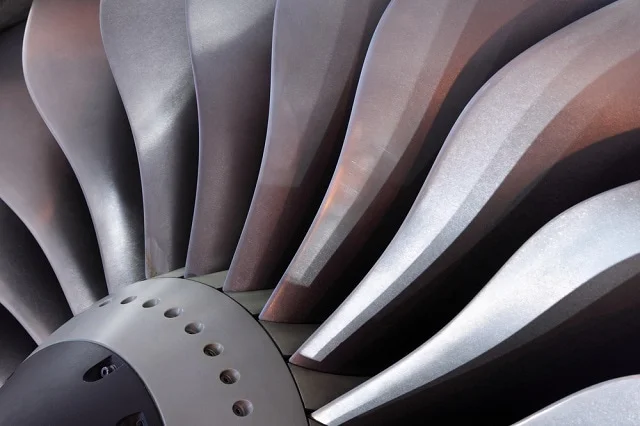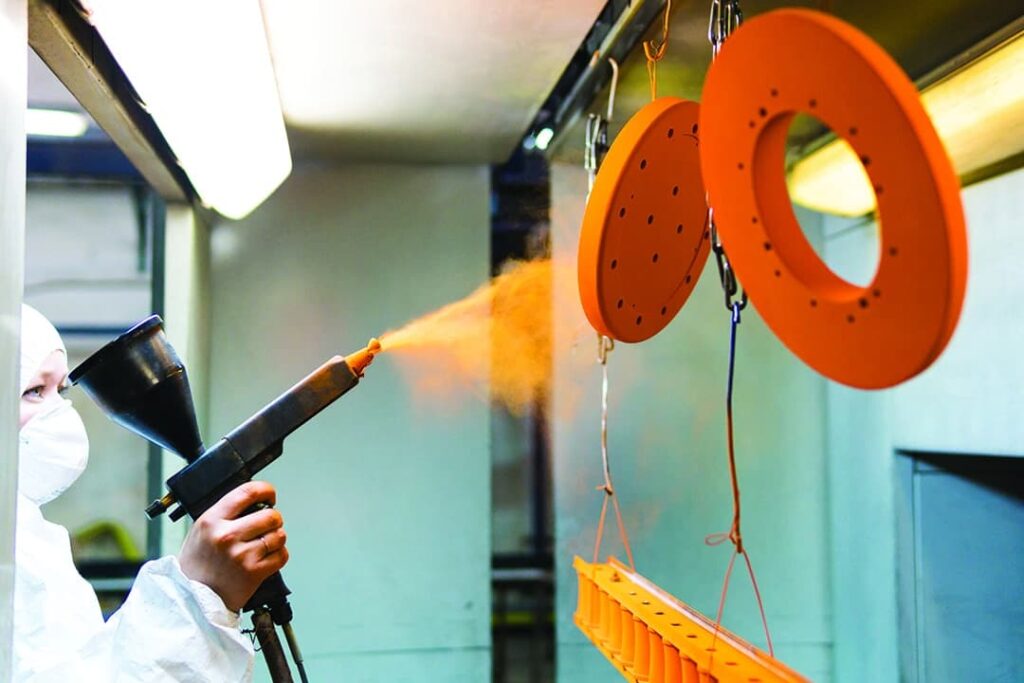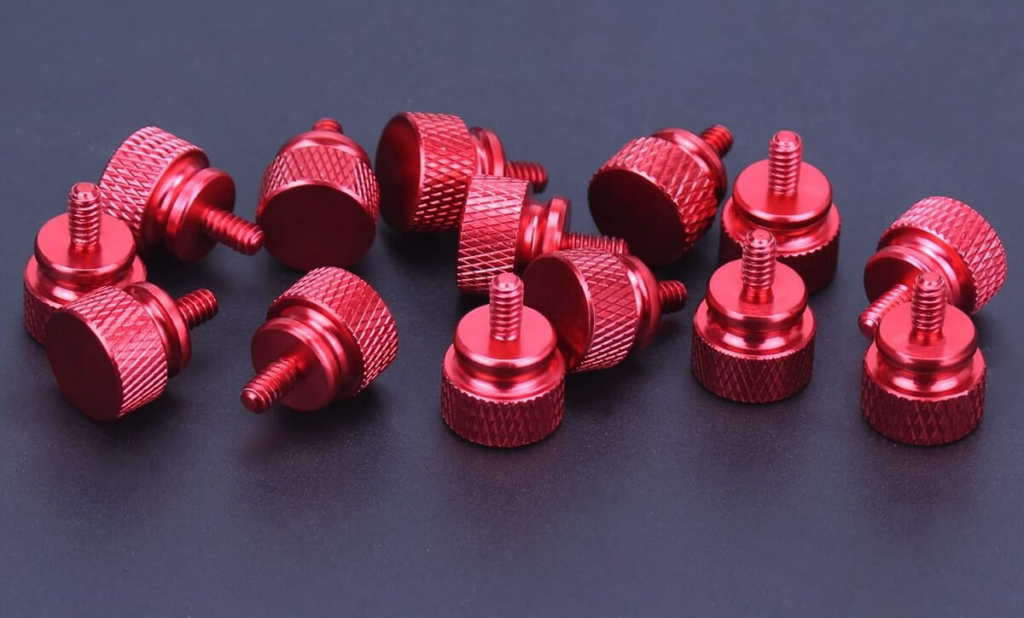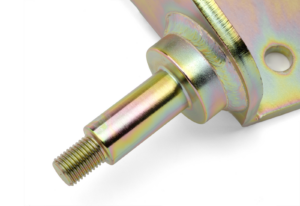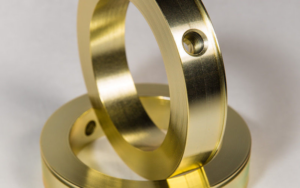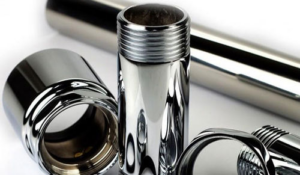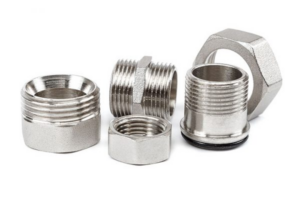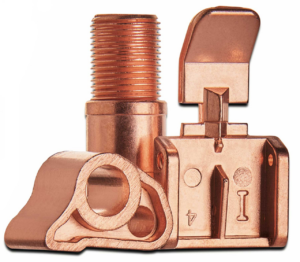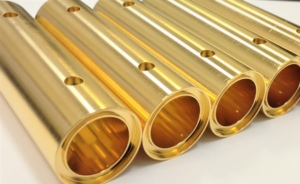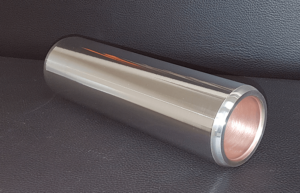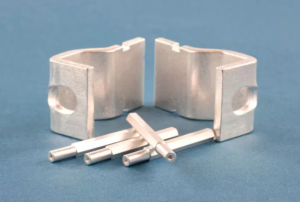The aerospace industry today is a multi-billion dollar industry. Millions of dollars are spent manufacturing and procuring aircraft, not to mention the safety measures needed to be in place. Materials used in this application are subject to harsh conditions that threaten their integrity.
Plating represents one technique used to protect aerospace metals from these harsh conditions, thereby increasing their lifespan and minimizing the risk of failure in service.
In this article, we will discuss aerospace plating, its importance, and the benefits of aerospace finish.
What Is Aerospace Plating?
Although there are many different metal kinds that can be electroplated, we’ll concentrate on titanium because it’s so common in the aerospace sector.
Titanium is a challenging metal to plate because an oxide coating forms very quickly and with great activity. Few other metals can link with a titanium substrate, necessitating the development of the plating-nickel titanium method.
It is simpler to weld other metals to the component if there is any underlying nickel coating. Due to the increased use of titanium, contemporary businesses have been attempting to optimize this procedure.
Electroless plating works well for places that are more difficult to access. This metal coating, which is created through a chemical reaction, provides uniform coverage on more intricate substrate surfaces. Along with other varieties of nickel alloys, nickel is also most frequently employed for this purpose.
- High Phosphorus Offers superior corrosion protection and improved resilience in extremely acidic situations.
- Medium Phosphorus A good choice for enhancing the substrate’s aesthetic appeal.
- Low Phosphorus Known to provide the best resistance to alkaline conditions and boost surface hardness and solderability.
Black electroless nickel coating is a relatively recent breakthrough that makes it easier to absorb light and energy. When a black finish is needed, this provides a more practical choice for withstanding harsh climates and situations while adding aesthetic applications.
What Is Plating?
Plating is a surface covering in which a metal is deposited on a conductive surface. The electroplate is used for corrosion inhibition, improved solderability, to harden, improved wearability, reduced friction, improved paint adhesion, altered conductivity, or for radiation shielding.
Aerospace plating is essential to the livelihood and growth of the industry. Reliability, precision, and the use of proper materials are crucial.
Metal Finish Vs. Surface Finish
There can be confusion when it comes to metal finishing and surface finish, which are different. As a matter of fact, they are entirely separate from each other, and one does not indicate the other. To help clarify the distinction between the two, we will identify the differences from a manufacturer’s point of view.
Metal Finishing is the process of adding a layer to the material in order to achieve a better appearance or improve its durability. These are the different types of metal finish you’ll want to know about:
Painting
Like with any sort of painting, coating the surface with a coat of wet paint is a requirement for metal painting. Typically, fabricators would employ pumps, sprays, or pressurized vessels to guarantee that the paint is applied uniformly.
Powder Coating
Powder coating gives metal a decorative finish that’s both durable and easy on the eyes. The process involves applying a dry coat of statically charged powder to grounded metal parts. These oppositely charged particles spread into a continuous coat when heated in a curing oven, giving the metal a polished and uniformly dispersed finish.
Anodizing
Metal is electrolytically coated with a protective or aesthetic oxide during the anodizing procedure. Aluminum can be used to grow aluminum oxide by putting it in an acid electrolyte bath and running electricity through it. The finished product is a strong, long-lasting coating that keeps the metal’s original sheen and grain.
Plating
A thin layer of metal is applied to a substrate as part of the metal plating process. For instance, gold or silver plating is frequently used on brass and woodwind instruments. Electroplating and electroless plating are used to create the finish. While electroless plating uses autocatalytic chemicals, electroplating needs an electric current.
Surface Finish is the process of removing a layer of metal to improve the appearance and/or functionality of the metal by limiting or adding peaks/valleys to create or limit a surface texture. Here are a few examples of common surface finish procedures
Grinding
The surface of a metal can be smoothed out using grinding machines. To produce the appropriate finish, these machines use compression, attrition, and friction. A fabricator may select from a variety of grinding machines that vary in type and design depending on how smooth of a finish is desired.
Polishing And Buffing
In order to get a better finish and prepare the metal for buffing, polishing entails scraping off the surface material. Buffing creates a high sheen, sometimes known as a mirror finish, and smooths the surface.
Abrasive Blasting
You can easily combine cleaning and finishing into one procedure with abrasive blasting. To achieve the necessary cleanliness and surface profile, abrasive particles are propelled against a metal surface using a high volume of pressure during abrasive blasting. In this technique, abrasives like sand, glass, plastic, and aluminum oxide are employed.
Milling
Fabricators will put the metal through a rolling mill, extrusion die or drawing process to get a mill finish. This style of finish typically feels harsh to the touch and is dull in appearance.
Anodizing And Coating
Anodizing
Anodizing is a simple electrochemical procedure that coats the surface of aluminum with a protective layer of aluminum oxide. The thickness of the applied anodic coating determines how long the finish will last.
Aluminum oxide shields the base metal by being tough, resilient, and weather-resistant. The coating may have a dyed hue or exhibit bronze tones due to the diffraction effects the coating produces. Through this electrochemical process, the coating develops from the aluminum metal’s foundation.
Because it is a part of the metal, the coating cannot peel or flake. The coating is composed of several tiny hexagonal pores that are sealed with an inert aluminum oxide “seal” after being hydrolyzed.
Powder Coating
The powder coating procedure is quite comparable to painting, with the exception that the “paint” used in the former is a dry powder as opposed to a liquid.
Due to the powder’s electrostatic charging and the parts’ grounding, the powder adheres to the parts. Any surface that can withstand the heat of the powder’s curing process and that can be electrically grounded to improve charged particle adhesion can be utilized as a substrate. The application of heat causes the powder to flow and cure.
Six Differences Between Anodizing And Powder Coating
Process
Anodizing is an electrochemical method used to make the natural oxide coating on aluminum thicker, boosting the metal’s endurance. The longevity of the anodized aluminum increases with coating thickness.
Powder coating is the process of using an electrostatically charged powder that is sprayed on the aluminum to apply a decorative and protective finish to the aluminum profile or any other metal.
Color Variation
Since anodizing is done in various batches, the substrate may vary in temperature. Since the powder remains consistent when powder coating, the substrate’s color never varies.
Cost
Powder coating is less expensive than anodizing.
Surface
While powder coating can be applied to any surface, including wood, steel, and aluminum, anodizing can only be done on surfaces made of aluminum. This results in a very consistent appearance.
Rework
While powder coating can be dented, fixed, and recoated, anodizing cannot.
Layer Lifetime
In comparison to powder coating, anodizing has a longer lifespan. The powder coating is vulnerable to deterioration from the elements. This layer may come off as a result of sunlight, oxidation, and dampness.
Advantages of Anodizing
- Anodizing is more durable than surfaces with a powder coating. In high-traffic locations where the coating is prone to physical abrasion and abrasive cleansers, anodizing is preferable for aluminum.
- Anodizing is immovable. Typically, the coating is a component of the metal.
- Compared to powder coatings, anodizing provides aluminum with a richer, deeper metallic appearance. This is due to the fact that an anodized coating is translucent, allowing one to see the basic metal beneath. The issues with color variance could be exacerbated by this translucence.
- Sunlight has no effect on anodizing.
Limitations of Anodizing
- Powder coating is less expensive than anodizing
- There are fewer color options
- Welded joints stand out more. There is no content that addresses cleaning, polishing, or grinding
Advantages of Powder Coating
- A variety of color options
- Extremely resilient to UV rays when the right substance is prepared, applied, and controlled
- Powder can be recovered and reused
- Since there is no VOC production, there is no need for VOC disposal
- The grinding, polishing, and welded joints are concealed to reduce their visibility
Limitations of Powder Coating
- Scratches make the contrast between the substrate and powder-coated surface more obvious
- Curing is energy intensive
- The skin may display more “orange” peel
- The powder coating may flake off or separate from the base material
Benefits of Aerospace Metal Finishing
Another significant benefit of products covered in a protective metal finish is the lengthened lifespan of the product. Metal will wear and deteriorate much more quickly without treatment than it would if it had undergone metal finishing.
Metals deployed in the aerospace industry are subject to very harsh service conditions. Subjecting these metals to high humidity and high-temperature environments can cause them to degrade quickly and increase the cost of maintenance.
Greater durability and abrasion resistance are provided by metal finishing, protecting against corrosion, chemical harm, and wear. This is particularly crucial in fields that depend on robust operational machinery.
Resistance To Heat
Metal plating increases the heat resistance of products, particularly when using a silver-plating process, which has a very high heat threshold. Due to this benefit, metal finishing is a preferred option in the aviation and automobile industries, where exposure to high temperatures is inevitable.
Increased Durability
Metal finishing increases the strength and hardness of metals, improving the endurance of the product. Copper and chrome plating are finishes commonly used for this purpose in industrial applications, including on tools, hydraulic cylinders, and mechanical products. This is particularly important in the aerospace industry as aircraft components can be costly to replace in the event of a failure in service.
Enhanced Appearance
Metal finishing can be achieved using a variety of methods, including silk screening, e-coating, powder coating, anodizing, and plating. The improvement to the overall aesthetic of the metal product, regardless of the procedure used, is the process’s greatest advantage.
The procedure helps to get rid of any sharp edges, clean, and then smooth the surface. A matte, glossy, or textured surface might be found on the finished product. This sophisticated method can also be used to remove a variety of other surface imperfections in addition to ugly and potentially harmful burrs. Glass beading, metal polishing, color application, and custom metal plating are examples of decorative possibilities that can be altered.
Other benefits include
- Enhanced oxidation resistance
- Improved solderability
- Better electrical conductivity
Which Plating Is More Durable?
You must take into account the unique attributes each metal offers and how significant they are to your finished product when selecting the best metal for plating. Corrosion resistance is an important factor in numerous industrial areas. Resistance to corrosion is crucial regardless of whether you are in the automotive, petrochemical, medical, power generating, or many other industries.
The most durable plating in this regard is Zinc plating. The reason for this is simple; Zinc has a higher standard oxidation potential than iron when compared to other metals like tin, copper, nickel that iron can be plated with.
What is Zinc Plating?
As the name suggests, zinc plating is a process whereby a thin deposit of zinc is applied to a base metal. A popular finish in many industries where corrosion is an issue, the coating forms a sacrificial layer on the metal that corrodes first, meaning that the original metal can be protected and the zinc layer replaced and repaired when needed.
How Does Zinc Plating Work?
Bright zinc plating is a multi-step procedure. Before the components can be dipped into the zinc solution, the base metal must be thoroughly cleaned using acids and water washes.
This results in a dazzling finish on the metal by leaving a thin layer of zinc on it. The plated metal can now be passivated in a chromate solution to add color and additional protection, as well as a second top coat seal for more robustness.
In order to stop high-tensile steel from becoming hydrogen embrittled, we can also apply a heat treatment procedure called de-embrittlement.
Zinc plating is typically applied to ferrous metals iron and steel. It is a very adaptable method that may be used with both small and large batches.
The method has uses in many sectors and is frequently used for plating objects, including fasteners, pressings, turning pieces, and springs.
Due to its ability to resist corrosion, it is appealing to industries that need durable, rust-free components, which accounts for its widespread use in many offshore engineering concerns.
How Many Types Of Plating Are There?
There are several types of plating in the metal finishing industry. Some of them include the following;
Zinc Plating
As earlier described, zinc plating is one of the most durable metal plating available. Zinc is an inexpensive material that is used to provide a galvanized coating on many metal substrates. In addition to being electroplated, the element is applied by way of the sherardising process, by molten bath dipping, and by spraying.
In the electrolytic or cold process, the article to be plated is set up as a cathode in an electrolytic bath of soluble zinc salts together with an anode of metallic zinc. The process produces a highly ductile coating of pure zinc whose thickness and uniformity can be precisely controlled.
Cadmium Plating
In the past, cadmium plating was frequently applied to many automotive parts and utilized as a zinc alternative. Its sacrificial protective qualities and natural lubricity for components that were regularly removed and reinstalled led aircraft makers to specify it. It was especially well adapted to marine situations since it can withstand both fresh and saltwater.
Although it is still accessible, its use as a plating material has decreased over time due to safety concerns. Zinc-nickel alloy plating has become popular among aircraft producers.
Chrome Plating
Although chrome plating is frequently only used for aesthetic reasons, it also promotes increased corrosion resistance and hardness, making it ideal for industrial applications where wear is a concern. Hard chrome plating, as it is known in this context, is occasionally used to restore tolerances on worn-out components. In the manufacture of steel furniture, car trim, etc., chromium is most frequently plated over nickel.
There is no anodic activity because nickel is typically plated over copper, and the combination of these three elements simply prevents the underlying metal from corroding by restricting air and moisture. In order to achieve adequate corrosion protection, the platings must be appropriately applied.
Hexavalent chromium, a chromic acid, is most frequently used in the electroplating process known as chrome plating. Another choice for industrial uses is trivalent chromium baths, which are mostly made of chromium sulfate or chromium chloride.
Chromate is occasionally applied on top of zinc plating to protect the zinc and, in some situations, change the color of the metal, as in the case of green or black zinc plating.
Nickel Plating
Because it works well in electroless plating, nickel is a common plating metal. For better ornamentation and wear resistance, household items like doorknobs, silverware, and shower fixtures are frequently nickel plated. Nickel plating serves as the underlying plating for chromium and frequently bonds with copper and aluminum, as well as a wide range of other metals.
An alloy made of nickel and phosphorus is utilized in electroless plating. Phosphorus concentrations in the solution can range from 2 to 14%. Phosphorus concentrations that are higher improve hardness and corrosion resistance. Lower phosphorus concentrations provide greater solderability and magnetism.
Copper Plating
Another common plating material for uses requiring excellent conductivity and cost-effectiveness is copper. As was mentioned before, copper plating frequently acts as a strike coating pretreatment for subsequent metal platings. Additionally, it is a widely used plating metal for electronic parts like printed circuit boards. Copper is one of the less expensive metals to plate with because of its high plating efficiency and cheap material cost.
There are three different methods for copper plating: acid, mildly alkaline, and alkaline. Superior throwing power is provided by higher alkaline levels, but these values also call for lower current densities and more stringent safety measures. It is crucial to keep an eye on these levels since cyanide in alkaline copper baths has been connected by health inspectors to a number of health risks.
Gold Plating
Gold is prized for its high resistance to oxidation and electrical conductivity. Gold plating, which differs from gilding in that the gold is not a foil, is one of the simplest ways to impart these characteristics on metals such as copper and silver.
The procedure is frequently used to decorate jewelry and to increase the conductivity of electronic components like electrical connectors.
The easiest way to avoid tarnishing when gold-plating copper is to apply a nickel strike before deposition. When deciding on elements such as the ideal bath combination and duration of immersion, also take into account the hardness and purity of the gold.
Silver Plating
Similar to gold, silver is used in plating processes where enhanced electrical conductivity and aesthetic appeal are required. Since silver is less expensive than gold and does a better job of plating copper, it generally functions as a more cost-effective plating solution.
Humidity and galvanic corrosion are two problems that could make silver plating less practical as a plating method. Because silver is prone to flaking and cracking, which could eventually reveal the base substrate, silver plating does not perform well for applications that are exposed to high humidity.
Tin Plating
Food and drink packaging has long been made of tin-plated steel. Tin is toxic-free, offers a coating that makes steel form quickly (due to the lubricity it offers), welds, and solders with ease, in addition to offering corrosion resistance. The tin plate is covered in food-grade oil during the passivation process, which also enhances lacquer adhesion. To better meet the needs of the interior and exterior container surfaces to their environments, tin plate sheets can be ordered with various tin thicknesses on each face. Other packaging materials, such as paint cans and grease tins, also use a tin plate. The hot-dip method is nearly always used to create the tin plate. Electronic parts are also made with the use of tin plating.
A tin-lead alloy was typically applied over steel in terneplate, another tin-based plating, as a corrosion inhibitor. The metal is perfect for use in tin roofs since it can be painted and, with routine maintenance, last 90 years. Tin is now used over stainless steel instead of lead to create corrosion-resistant roofing that takes on a softer patina. The material has a two-times longer lifespan than copper roofing.
Rhodium Plating
A kind of platinum known as rhodium offers resistance to tarnish, scratching, and a glossy, white dazzling luster. Rhodium plating is frequently used in the manufacture of jewelry, particularly when white gold needs to be plated. Rhodium plating is also common on base metals, including copper, platinum, and silver.
One drawback of rhodium plating is that in applications that experience a lot of wear, the protective layer of rhodium will eventually disappear. After a few years, this can result in discoloration and call for another round of plating.
Importance of Aerospace Plating
The majority of modern aircraft are made of titanium and titanium alloys. For aerospace crafts, titanium is highly valued because of its low density, high strength, and lightweight. Steel, aluminum, and magnesium are other regularly utilized metals.
Even though these metals are fundamental to the manufacturing of aircraft, they are not without flaws. These metals are nonetheless prone to oxidation, corrosion, and decomposition at high temperatures. Aircraft plating is utilized as a metal finishing procedure to shield aerospace metals from various risks to their integrity.
Electroplating and electroless plating are the two main plating techniques. By adopting a method called electrodeposition, electroplating entails covering a metal surface with ions of another metal.
Benefits of either type of aerospace plating include:
- Improved corrosion protection
- Enhanced strength of the metal substrate
- Increased resistance to high temperatures
- Component longevity
- Enhanced electrical conductivity
- Increased resistance to oxidation
- Aesthetic appeal
A Finish For You
In order to get the best out of any aerospace finish, it is important to consult only reputable experts. Valence is the industry leader in quality for precision components in the aerospace, satellite, electronics, and medical device industries. With unique selective plating and precision masking techniques for critical plated components, we are the leading plater for satellite and UAV applications, including a proprietary process for precision internal plating of waveguides.
We offer integrated honing and grinding capabilities to complement our cadmium and chrome plating. Check out the Valence process for more information on services and capabilities with your next project.
